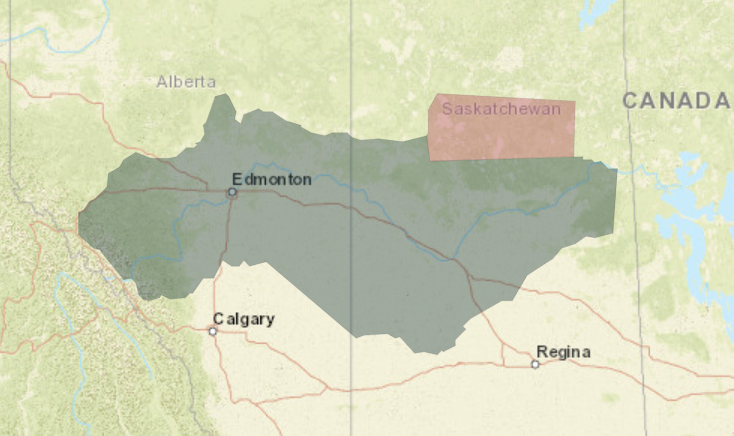Treaty 6 Information
Land Acknowledgment
“The University of Alberta, its buildings, labs, and research stations are primarily located on the traditional territory of Cree, Blackfoot, Métis, Nakota Sioux, Iroquois, Dene, and Ojibway/Saulteaux/Anishinaabe nations; lands that are now known as part of Treaties 6, 7, and 8 and homeland of the Métis. The University of Alberta respects the sovereignty, lands, histories, languages, knowledge systems, and cultures of First Nations, Métis and Inuit nations."
What Is Treaty 6?
Treaty 6 territory refers to a specific area of land in what is now known as Canada, where the Treaty 6 agreement was negotiated and signed between Indigenous nations and the British Crown (later the Canadian government) in the late 19th century. The territory covered by Treaty 6 encompasses parts of present-day Alberta and Saskatchewan.
Since its signing in 1876, there have been numerous conflicts between the Indigenous signatories and the Canadian Government over varied interpretations of the terms of Treaty 6, specifically relating to land ownership/transfers. Indigenous signatories were not familiar with the settler concept of land ownership when the treaty was signed and instead believed Treaty 6 was signed as an agreement to share and steward the land together. In return for the contested cession of the majority of Treaty 6 lands, Indigenous signatories were promised certain benefits, including annual payments, education, and medical support, although they have had to continuously fight for these benefits since the signing took place.
We actively recognize and acknowledge Treaty 6 regularly to ensure that our settler society does not forget its obligations to equitably share these lands with First Nation, Metis and Inuit peoples, respect the sovereignty of their nations, and be proactive participants in their overall well-being. Both historical and ongoing injustices and forms of discrimination against Indigenous peoples must be called out and combated whenever possible, and we take this mission extremely seriously as an institution of learning.
Why Do We Do Land Acknowledgements?
To quote the University of Alberta Centre for Teaching and Learning:
Acknowledging Treaty 6 territory is essential for building respectful relationships, acknowledging injustices, and working towards a more just and inclusive society that values the rights and contributions of Indigenous peoples.
"To acknowledge the traditional territory is to recognize its long history, reaching beyond colonization and the establishment of European colonies, as well as its significance for the Indigenous peoples who lived and continue to live upon this territory, and whose practices and spiritualities were tied to the land and continue to develop in relationship to the land and its other inhabitants today."
How Can I Learn More About Indigenous Peoples?
First and foremost, the best way to learn about Indigenous peoples is to meet them! There are countless opportunities to spend time in Indigenous spaces, at Indigenous events/ceremonies, and with your Indigenous classmates/colleagues here at the University of Alberta. You can find an up-to-date list of Indigenous stories, initiatives, and events happening on campus here.
Of course, since this is a university, you can learn about Indigenous peoples by taking classes! As one of the only universities in Canada with a Faculty of Native Studies, students from all walks of life can take courses that will expand their knowledge of Indigenous peoples, cultures, and histories.
Find the full Native Studies course catalogue here.
Find the popular "Indigenous Canada" online course here.
How Can I Contribute to Truth and Reconciliation?
-
Education and Awareness
- Read books, watch documentaries, and engage with Indigenous-authored content.
- Take part in workshops, lectures, and community events that focus on Indigenous issues and perspectives.
- Share what you learn with your friends, family, and your community to amplify Indigenous perspectives in your circles.
-
Support Indigenous Businesses and Artisans
- Purchase products and services from Indigenous-owned businesses and artisans. This helps support their economic well-being and promotes cultural preservation.
- Attend Indigenous craft fairs, markets, and exhibitions to learn about and appreciate Indigenous art, craft, and culture.
-
Volunteer and Engage
- Volunteer with Indigenous organizations, community centers, or educational programs to contribute your time and skills.
- Attend community meetings and engagement sessions to listen to Indigenous voices and perspectives.
-
Cultural Exchange and Collaboration
- Seek opportunities for cross-cultural exchange and collaboration with Indigenous communities. Building relationships and partnerships can lead to mutual understanding and shared initiatives.
- Seek opportunities for cross-cultural exchange and collaboration with Indigenous communities. Building relationships and partnerships can lead to mutual understanding and shared initiatives.
-
Support Indigenous-led Initiatives
- Participate in events, ceremonies, and gatherings organized by Indigenous communities!
- Support campaigns and initiatives focused on issues such as land reclamation, language revitalization, and cultural preservation. Solidarity matters.
-
Acknowledge Traditional Territories
- Begin public events, meetings, or presentations by acknowledging and respecting the traditional territories of Indigenous peoples in your region.
- Begin public events, meetings, or presentations by acknowledging and respecting the traditional territories of Indigenous peoples in your region.
-
Contribute Financially
- Donate to Indigenous organizations, projects, or educational initiatives that promote cultural revitalization, healing, and empowerment.
- Donate to Indigenous organizations, projects, or educational initiatives that promote cultural revitalization, healing, and empowerment.
-
Reflect and Unlearn Bias
- Reflect on your own biases and assumptions, and actively work to unlearn stereotypes and misinformation about Indigenous peoples.
